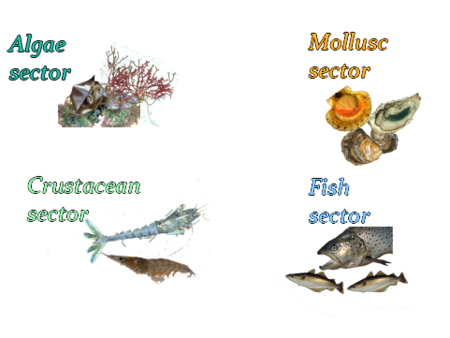Undaria
Name : | Wakame |
|---|---|
Scientific name : | Undaria pinnatifida |
Size : | This brown alga - Laminarial family – can be between 1.5 to 3 meters in length. |
History: from the pioneers to today
This alga originates from Japan, where it has been cultivated for several decades. It was introduced accidentally in France at the beginning of the seventies. At first, it populated the Thau Lagoon (Herault), then cultivation tests were carried out in Brittany and along the west coast (Charente-maritime).
Since the beginning of the nineties, it is included in the list of alga species authorized for human consumption.
Culture techniques and production cycle
This species can be farmed using two techniques:
Originally, in Asian counties, spores are collected at the end of spring and they are immediately cultivated in ponds, where a controlled light will keep them in a latent state until the month of September, at which time they are put to sea on substratum made of ropes. Harvesting takes place 5 months later.
A new technique has been developed and applied in France, based on an rather special idea from Korean scientists. Once the spores have been collected in spring, they are cultivated in laboratories using techniques close to those used for the microalgae. Through precisely controlled light and temperature, the reproducing elements (gametes) are blocked, to the benefit of the cells that give them life (gametophytes). It is then possible to produce large quantities of reproducing cells which can then be brought to maturity – any time of the year – to form gametes.
Evolution of the production
The production grew significantly in the early seventies, but has been going through a recession since the end of the nineties in all the producing countries.
In France, so far, the production is very limited, ranging from 10 to 50 tons per year.
The production sites are in Brittany (Le Guilvinec, St Malo).
Product value enhancement
Algas are usually consumed fresh. A pickled preparation known as “sea mustard” enables algas to be preserved for a longer period of time (1 to 2 months).
A more recent product, called “cut wakame” has enabled the storage duration to be considerably extended (from 8 months to 1 year). A specific process makes it possible to obtain algas as small granulates which, once they have been rehydrated, form pieces of algas that exhibit the original taste, color and texture.
Economy
Value of Undaria pinnatifida production in the last few years ( x US$ 1,000)
Pays | 1995 | 1996 | 1997 | 1998 | 1999 | 2000 |
|---|---|---|---|---|---|---|
Japan | 175 726,8 | 107 415,1 | 94 510,7 | 101 490 | 125 794,3 | 110 015,4 |
South Korea | 22 500 | 25 000 | 18 388,2 | 18 150 | 18 150 | 17 600 |
North Korea | 49 707 | 45 872 | 56 143,4 | 28 757,5 | 28 756,3 | 21 244 |
France | 6 | 3,2 | 2,8 | 3 | 1 | 1 |
Total | 247 939,9 | 178 290,3 | 169 045 | 148 400,5 | 172 701,6 | 148 860,4 |
In South Korea and Japan, fish farmers have set up very powerful cooperatives which manage most of the production. The farmers rotate the use of the most productive plots at sea so that nobody is penalized.
French Market: the French production is consumed domestically. Attempts to export to Japan failed to achieve the expected success.
Strengths / Weaknesses
Strengths | Weaknesses |
|---|---|
|
|

